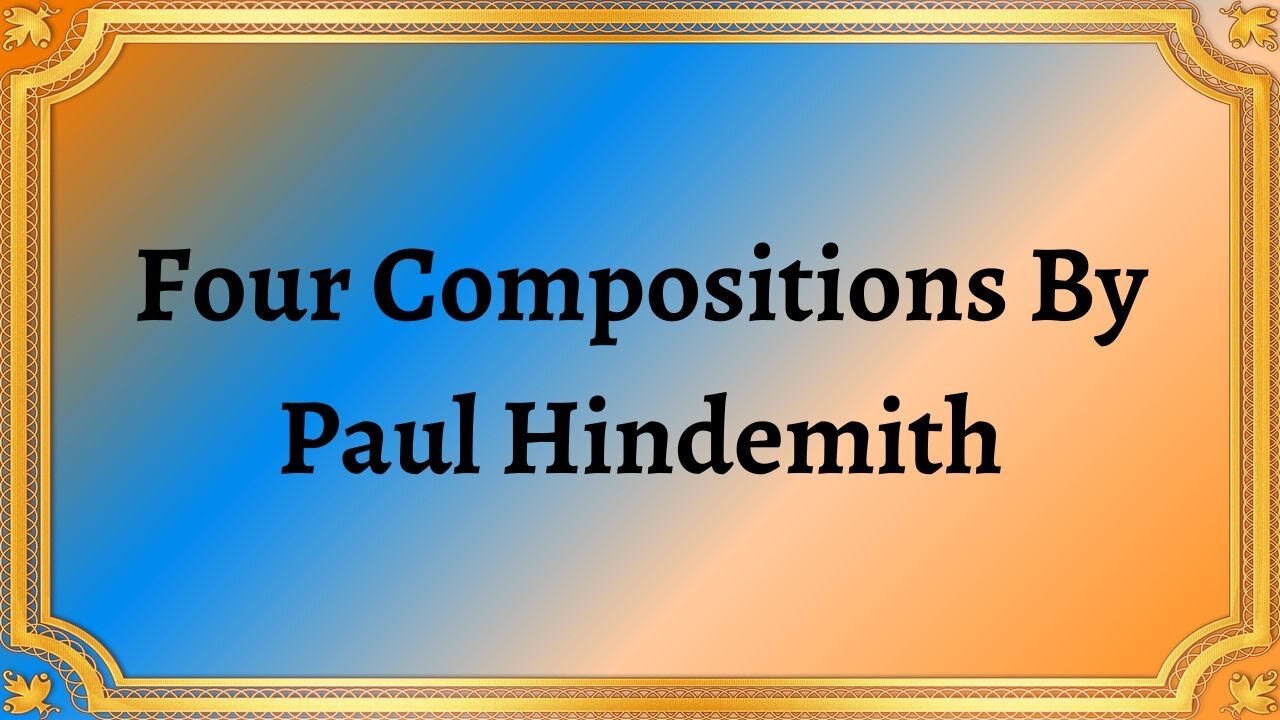Premium Only Content

Four Compositions By Paul Hindemith
#classicalmusic #PaulHindemith #FourCompositions #musicalcomposition #musicappreciation #composer #20thcenturymusic #classicalmusicians #musicianlife #orchestralmusic
Publication date 1951
1. Eight Pieces For String Quartet (00:00)
2. Trauermusik For Solo Trombone And Strings (08:53)
3. Morning Music For Brass Instruments (16:11)
4. Sonata For Trombone And Piano (23:36)
DAVIS SHUMAN. TROMBONE: WITH THE RADIO ARTISTS STRINGS
DAVIS SHUMAN, CONDUCTOR
SAM RAPHLING, PIANO
Classical music has a rich history filled with masterpieces that have stood the test of time. Among these extraordinary compositions is "Four Compositions" by the renowned composer, Paul Hindemith. In this essay, we will delve into the intricacies of this remarkable musical piece, exploring its significance, structure, and the genius behind its creation.
To truly appreciate "Four Compositions," it is essential to understand the composer behind it. Paul Hindemith was a German composer and musician who lived from 1895 to 1963. Hindemith's musical journey was shaped by his early exposure to various genres, including traditional classical music, jazz, and folk music. These diverse influences can be heard in his compositions, including "Four Compositions."
"Four Compositions" is a collection of four distinct pieces that showcase Hindemith's mastery of composition. Each composition presents a unique musical journey, exploring different themes, harmonies, and rhythms. The structure of the piece is carefully crafted, allowing for seamless transitions between movements while maintaining its individuality.
Hindemith's compositional style in "Four Compositions" is characterized by its intricate harmonies, rhythmic complexities, and the innovative use of tonal and atonal elements. The piece showcases a blend of both traditional and avant-garde techniques, which reflect Hindemith's experimentation with musical forms during the early 20th century.
"Four Compositions" is considered a groundbreaking work that challenged the traditional norms of classical music. Hindemith's adventurous spirit and willingness to explore new musical territories paved the way for future composers to experiment and push the boundaries of the art form.
The impact of "Four Compositions" extends beyond its initial creation. It has served as a source of inspiration for generations of composers, influencing their approach to composition and expanding the possibilities within classical music. Hindemith's innovative use of harmonies, rhythms, and forms continues to resonate with musicians and audiences alike.
"Four Compositions" by Paul Hindemith stands as a testament to the composer's brilliance and his contribution to the world of classical music. Its intricate structure, innovative techniques, and enduring legacy make it a remarkable piece that deserves recognition. Through exploring this masterpiece, we gain insight into Hindemith's musical genius and gain a deeper appreciation for the evolution of classical music during the 20th century.
You have the opportunity to support the channel https://destream.net/live/RadSiarAl/donate
-
 32:30
32:30
Classical music_Music Inspiration
1 month agoArturo Toscanini Grand Canyon Suite
1001 -
 LIVE
LIVE
Barry Cunningham
1 hour agoPRESIDENT TRUMP IS BUILDING A NEW MAGA! ARE YOU READY FOR THE NEXT ACT?
2,795 watching -
 LIVE
LIVE
Dr Disrespect
8 hours ago🔴LIVE - DR DISRESPECT - STREAMING UNTIL WE GET 10 WINS
1,989 watching -
 LIVE
LIVE
RiftTV
2 hours agoCON INC: We Should All Just FORGET About Epstein | The Rift | Dinesh D’Souza, Lauren Witzke + More
600 watching -
 LIVE
LIVE
LIVE WITH CHRIS'WORLD
1 hour agoLIVE WITH CHRIS’WORLD - I Have So Many Questions Right Now
79 watching -
 58:21
58:21
BonginoReport
3 hours agoTrump Deepens MAGA’s Epstein Divide - Nightly Scroll w/ Hayley Caronia (Ep.91) - 07/16/2025
110K62 -
 LIVE
LIVE
RalliedLIVE
5 hours ago $0.85 earned10 WINS WITH THE SHOTTY BOYS
83 watching -
 LIVE
LIVE
Playback Request Live
1 hour agoLevel Up: Our First Live Performance ft. Lady Desiree
140 watching -
 LIVE
LIVE
Blabs Games
55 minutes agoBig Bad Uno Plays | Noob Plays
31 watching -
 LIVE
LIVE
The Jimmy Dore Show
2 hours agoTrump Attacks His OWN Supporters As Democrat Dupes Over Epstein! Columbia University CAVES to Trump!
7,460 watching